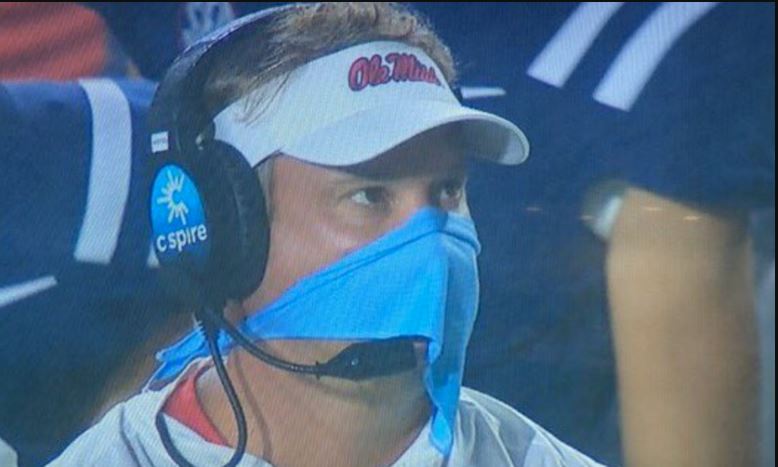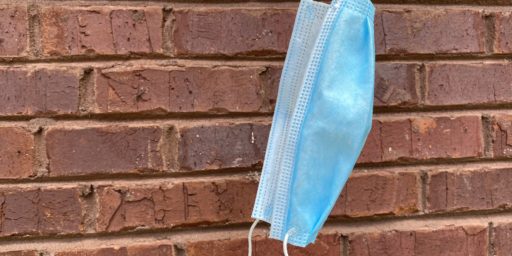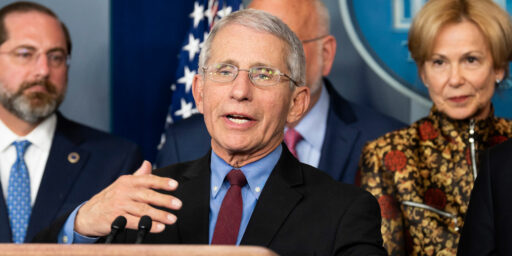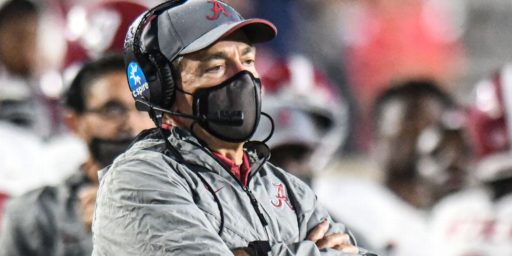Masking, Science, and Public Health
Guidance from WHO, CDC, and local governments differs widely and for good reason.

Ashish K. Jha, dean of Brown University School of Public Health, offers the best explanation I’ve encountered for the contradictory and therefore confusing advice coming from public health agencies regarding “masking indoors in the age of the Delta variant.”
The rise of the Delta variant of COVID-19 is causing concern and confusion about how best to avoid getting sick and spreading the disease. The confusion worsened with seemingly contradictory guidance on wearing masks indoors if you are fully vaccinated. The World Health Organization said vaccinated people should continue wearing masks indoors, as did the Los Angeles Health Department. The Centers for Disease Control and Prevention maintains that fully vaccinated people need not wear masks indoors.
Confusing. So who’s right and how are Americans to navigate this?
First, let’s get the science clear. If you are fully vaccinated and encounter the Delta variant, you are about 90 percent less likely to be infected than if you had not been vaccinated. And if you do get infected, you are extremely unlikely to get very sick. These facts underlie the CDC’s guidance that vaccinated people don’t need to wear masks indoors.
But here’s another way to see it: 90 percent is not 100 percent. And if a vaccinated person encounters the virus repeatedly or in high enough concentrations, the chances of a breakthrough infection gets more substantial.
That’s been my lay understanding. But here’s the thing: “the science” isn’t the only factor in public health policymaking. Decisionmakers have to balance health risks—hopefully, fully informed by the science—against economic impacts, public attitudes, and all manner of other factors.
Los Angeles, meanwhile, has vaccinated half its residents — a great start, but not enough to prevent the spread of the highly infectious Delta variant. With cases climbing, the LA Health Department decided to ask all residents, vaccinated or not, to wear masks in indoor public spaces — stores, movie theaters, public transit. Reasonable people can disagree whether it’s necessary, but ultimately it’s a local decision.
And this explains the CDC’s reluctance to change national guidance. Because no single policy or recommendation could possibly make sense for every region and every state. Massachusetts has fully vaccinated more than twice as much of its eligible population as Mississippi. Infection rates in Mississippi are about six times higher than they are in Massachusetts. The coronavirus pandemic is playing out differently state by state, community by community. Guidance needs to acknowledge that reality.
Here’s another way to think about it. Being fully vaccinated is like getting a great hockey goalie (think of Boston Bruin legend Gerry Cheevers) who blocks around 90 percent of attempts. In Massachusetts, there isn’t much virus around to even put a shot on target, and therefore little reason to wear a mask indoors. In Mississippi, there are simply many more shots on goal, and even a terrific goalie will occasionally let a shot in.
And, of course, hockey analogies are a lot less useful in explaining things to the local citizenry. But, more seriously, to the extent CDC is issuing national-level guidance, it’s quite reasonable to say that those who are fully vaccinated should be free to make their own decisions with regard to masking. But, alas, local politics vary. Mississippi should almost certainly have an “everybody wears a mask” mandate well ahead of Los Angeles but Angelinos are much less resistant to such a policy.
But how much should we care about breakthrough infections — infections that occur among vaccinated people? Here there are some things we can say with certainty, and others much less so.
Breakthrough infections are usually mild but occasionally can be miserable, with high fevers, headaches, and even loss of smell and taste. They rarely lead to the kind of COVID pneumonia that lands people in hospitals or kills them. That’s good. We don’t know if breakthrough infections are associated with long COVID — the dreaded long-term side effects that many fear. Most experts believe that the risk of long COVID in fully vaccinated people who get infected is much less likely. But we don’t know.
Finally, there is the issue of practicality. If a community is experiencing rising infection rates, it should ask unvaccinated people to mask up but could leave fully vaccinated people alone. The reality is that, without vaccine verification systems, that’s just not possible to enforce. So local public health officials have a simple choice: Ask everyone to mask up or acknowledge that few will. Rely on an honor system for masking, or ask everyone to mask.
As we wind our way through this pandemic, we are now entering a phase where guidance will — and should — be local and will change as the realities on the ground change. The Delta variant represents one such changing reality. And the guidance from public health agencies will need to become more nuanced.
The evidence right now says if you live in a highly vaccinated community with low infection rates, fully vaccinated people can skip the mask if they are willing to tolerate a minuscule risk of a breakthrough infection. For people who live in low vaccination, high infection communities, the choice is different: Mask up indoors or be willing to accept a far more meaningful risk of getting the virus.
But, again, science and public policy are distinct animals. Most of the localities with high infection rates are those with low vaccination rates and, as already discussed this morning, that’s almost entirely a function of politics and culture, not availability.





Of course those people in those regions that are
reluctantrefuse to be vaccinated won’t mask up anyway. FREEDUMB! What’s the use? The CDC could, but won’t, ID regions where individuals should be masking indoors, but the reaction to that…I’m going to continue doing the patriotic* thing and wear a mask.
* where patriotic is defined as protecting my fellow Americans.
Most people want to live in a deterministic world, none of this networked probabilities stuff. All experts providing the same deterministic advice, eg, wear masks now and on Sep 13 we can all take them off and throw them away. No strange new viruses where different experts make different educated guesses about what’s important. No evolution where the old virus becomes something new and the rules about behavior change.
@Michael Cain:
I kind of wonder when people became binary computers.
@Kathy:
When they are programmed into thinking that masking up and vaccination was programmed left wing performative empty hypocricy.
We saved their asses and they resent us for that. In some dim recess they realize they are coasting on our goodwill. Some do.
Not that I would advocate for not saving their asses, that would be wrong, counterproductive and sociopathic.
A smidge of gratitude would be appreciated.
Within a pandemic refusing vaccination is incredibly fucked up politics. We carried you to the finish line and you hate us for that.
And with Delta variant not even to the finish line.
I strongly suspect COVID manifestations yearly akin to yearly influenza. I expect boosters annually.
On a personal level, the decision of whether and where to mask up (or simply not engage in the particular activity in the first place) is also a function of how inconvenient I find the mask and how much I value the activity. Unlike many others, apparently, I find wearing a mask to be relatively tolerable, with N95s actually being more comfortable for long wear than the ear-loop surgical masks most people seem to favor, so masking up isn’t much of a problem for me in most situations. And as for activities, I’ve discovered that most indoor activities just aren’t that valuable to me. Sure, I have to get groceries, go to the doctor, run the occasional errand, etc., but I don’t actually *enjoy* window shopping in a mall for hours at a time, eating in a restaurant is nice on special occasions but I don’t really miss the random outings, I was never much of a bar person, movies are a loss but my big screen TV is an acceptable substitute for all but a few spectacle films each year, etc. And, having just bought a house and hiring various contractors and service providers to come do work, I’m perplexed by their common expression of surprise when I ask them to mask up before coming into my home, as I place pretty close to zero value on the cable guy’s desire to not wear a mask for the 30 minutes he’s in my living room!
At any rate, I get that others derive higher value from various indoor activities than I do, so for them, the low risk (if one is vaccinated) of participating in those activities is easily outweighed by the benefit for them, but not for me in most cases. I do still find it hard to understand why so many people find masks intolerably uncomfortable, though. How are people perfectly ok with wearing a wool suit, leather shoes, and a tie all day in DC heat, for example, yet find even a simple cloth or paper mask so utterly miserable that they’re willing to accept even a small but still real chance serious illness in the midst of an ongoing pandemic? It just doesn’t compute for me.
Agreed. At least for a few years until global vaccination rates are high enough to reduce the pool of infections in which variants can arise.
Of course then there is this, where Missouri Gov Parsons (R) is having difficulty squaring reality with his politics.
Wonder if he let the state’s public health make the request so that his prints wouldn’t be on it?
@Sleeping Dog:
The CDC shouldn’t call anyone out.
But they should state that regions below a certain threshold of vaccinations should require masking, below a higher threshold with rising delta should consider requiring masking, etc.
And then make the local data available and searchable.
Not quite the same, and it puts the onus on states and counties to act or not act, while setting up the obvious questions.
But it should be vaccination and infection rates. South Dakota might not need to mask, even with a lower vaccination rate than Mississippi, as case counts could be lower (due to luck and already having had a massive wave).
@Sleeping Dog:
Iowa Governor Reynolds botched COVID as badly as can be imagined. I look forward to D candidates challenging her hard in 2022.
That and many other shit things R legislature and Governor can do unchallenged. Teaching true American history is illegal here now.
I kinda want to set up study groups locally outside of the bounds of public schools highlighting facts your representatives deny you.
Kids deserve better than state imposed bull-shit.
@R. Dave:
I’ve been wondering the same thing for over a year.
Citing the Michael Reynolds’ principle might help: there’s no such thing as one motivation.
Take my boss (and keep him, please). I’m 100% sure he doesn’t wear a mask at the office because no one can tell him he has to. That is, rank hath its privileges, and so what if he got COVID and spent days in the hospital? He survived, didn’t he? At least he got both doses of AstraZeneca.
There may be other motives as well, but I believe that’s the main one. Evidence, it tracks for his habit of not using the company Uber account, or the company-paid gas card, or other things along those lines.
I concede masks are uncomfortable. But you get used to them after a while, like wearing shoes. I usually won’t wear one where I don’t have to, but sometimes I do. For instance, if I come to office on a weekend to do the petty cash reports, I tend to keep my mask on even though I’m alone.
@de stijl: Yeah but even in the Des Moines metro it was sketchy and a lot of people weren’t wearing masks. I was bartending and last year on NYE it was a nightmare. And once the surrounding counties dropped their mask mandates and opened up their bars and restaurants anyone from any of the surrounding counties seemingly would get mad if you told them they had to wear a mask unless they were seated. It was crazy to me.
Sadly, I moved away from Des Moines in February and now reside in the much more sane state of Alabama. Alabama relaxed its masking restrictions after Covid Kim but still probably too early as no one down here is getting vaccines.
I wonder where you all reside at, some place where people live in chronic fear or a virus- to the point that their afraid to leave their homes and such? Even my Democrat friends stopped “masking up” a year+ ago as our state opened up with little/no real restrictions. Some of the inner cities (read “easily misled”) ate it but the wise people just headed to the suburbs, because that’s where the fun is without all the violence.
I do see some people wearing masks here and there, but it’s their choice I guess.
It reminds me of SE Asia where they wear masks because the air sucks and disease runs a bit more rampant, we really don’t need to act like that.
@DaveD:
I’m eyeballing Duluth up nort’.
I have local connections that makes bailing departure difficult.
Business is easy. Personal is much more tricky.
@DaveD:
If you do not mind sharing where did you work?
I am a tiny partial owner in Full Court Press. I hope not in any of our joints based on your lived experience. Those folks are pretty like minded in that good and happy staff make for good repeat customers you want back. A happy circle of virtuousness. That is the goal.
If so, let me know.
I was at Carl’s and for the most part people were ok but after they allowed the bars to stay open past 9 and all the restrictions came off it got kinda bad. There was definitely a point where people just got fed up and there was absolutely zero guidance from the governor’s mansion. The longer the pandemic went on the harder it got even after that spike over winter. That said I miss that bar and that job.
@de stijl: I’d say maybe it was better for FCP properties because they are restaurants. But I have friends that work for certain orchestrate properties that had issues with out of towners especially when any of the state competitions were going on at wells fargo so who knows. Lets just hope those people had a chance to get poked.